From Vikings to Open-Faced Sandwiches: 15 days from Oslo to Copenhagen and Stockholm
By Kim Andersen, Clinical Associate Professor, WSU Honors College
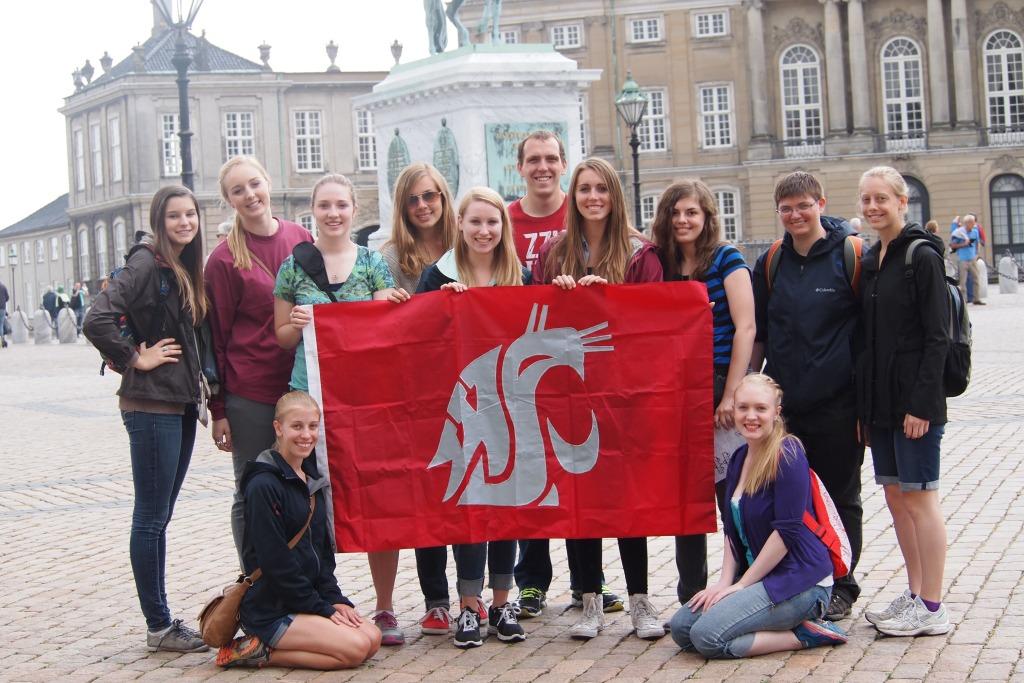
Much airspace leads to Oslo: we all left the U.S. June 22, 2014 and arrived Oslo on the 23rd - 9 hours ahead as they are in Europe. Some came via Reykjavik, some by London or Amsterdam but the whole group of 12 WSU Honors students and myself as faculty-leader took the commuter train from Gardermoen Airport to downtown Oslo and hiked through the busy streets to our hotel in glorious sunshine.
Faculty-led trips are a great way to see the world in a meaningful way. You experience a foreign culture within the structure of a class and the academic component that goes along with it. We had met throughout Spring semester for research and discussions on the cities and events on our itinerary and to identify topics for individual research papers. Most importantly the group got to know each other which comes in handy during intense weeks of travel. It turned out to be a great group: mutually supportive, academically interested in museums and sights, and with the necessary measure of spunk.
The title of the course was “Scandinavia: the Vikings and Beyond.” Scandinavia are modern Western European nations of high living standards, universal healthcare, economic and social equality, and a vibrant social and arts scene. Norway, Denmark, and Sweden are also conscious of their common Viking past and beyond that ancient time their histories are intertwined in language and culture. It was our purpose to make connections between the historical past and the present to gain the kind of cultural understanding only possible when venturing beyond textbooks.
What a classroom it was! In Oslo City Hall our excellent guide described how the Hall was conceived as an architectural celebration of equality somehow achieved in communal sentiment between the Norwegian people and the royal family. Inaugurated in 1950 in the post-WWII years, stunning, colorful paintings with mythological overtones of the nation’s history graced the enormous walls.
At the National Gallery we witnessed the strong Norwegian national sentiment in 19th and 20th century art. Adolph Tidemand’s painting “Bridal Procession in Hardangerfjord” (1848) wonderfully embodies national-romantic style. Edvard Munch’s “The Scream” (1893) signaled a more complex relationship to national pride perhaps.
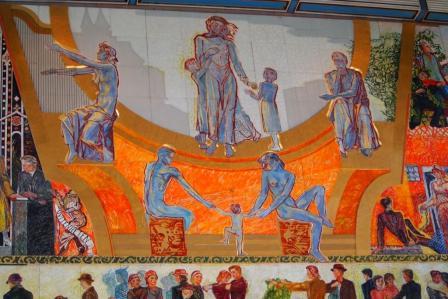
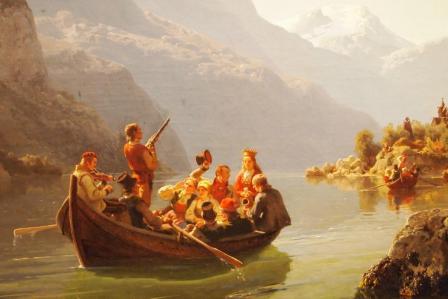
The second day we took the little ferry across the bay to the Norwegian Folk Museum and the Viking Ship Museum. At the Open Air Folk Museum we gradually approached the Vikings in time. The museum has brought together old log houses from across Norway including the Gol Stave Church dated A.D. 1212, close enough to Viking times. We found a small log cabin, recently deserted by staff, with warm ashes in the central hearth providing authentic atmosphere: this was essentially how Viking groups lived. What an outstanding classroom for illumination and sharing perspectives. We had class sitting between the beams; we could almost feel the light dropping down through the smoke-hole.
The Viking Ship Museum shows three impressive Viking vessels, the most notable the Oseberg Ship from the 9th century which eventually became the grave for a woman of high status. The ship was packed with what a Viking would need in the afterlife: richly carved sleighs, provisions, tapestries, tools and much more. Everything on display.
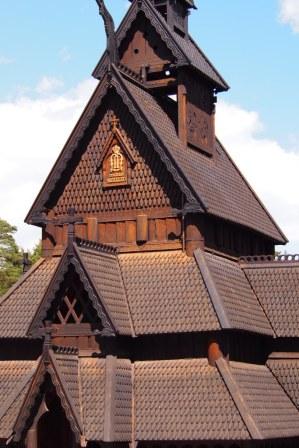
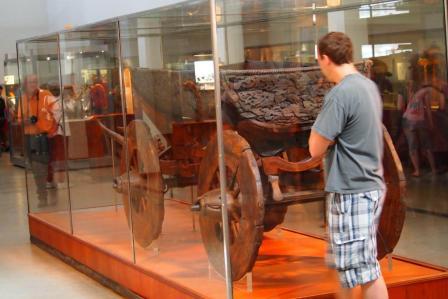
The biggest hit was probably the Vigeland Sculpture museum and park showing Gustav Vigeland’s (1869–1943) quirky sculptures of nude bodies in light-grey granite, natural size, oversized, granite-humans curling into giant columns, playing with any number of babies in their hands, or gently being caressed by a monster from some lagoon. You’ve got to see it to believe it and perhaps be Norwegian to appreciate it. But – a lot of fun. Eventually thunder, lightning and a torrent of rain turned the streets into new fjords as the day ended.
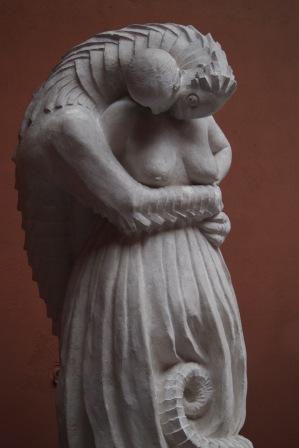
The overnight ferry left Oslo in the afternoon and got to Copenhagen the next morning. It gave us some sense of what it must have been like seeing the fjords and breathing the air when Vikings sailed south from Norway. At least we took the same route. Students thoroughly enjoyed trying to fit four into the diminutive 4-bunk cabins with full bathroom and shower service. If you could squeeze in. Well, well, just for one night. The ferry was more like a cruise ship with plenty of shopping, dining, and entertainment facilities. The view from the top deck was marvelous and the gentle roll of the vessel eventually put us to sleep.
The following morning we glided by Hamlet’s Castle, Kronborg (built 1420) guarding Elsinore, Denmark, with Sweden to our immediate left. Back then southern Sweden was a lovely part of Denmark and the castle built to enforce sound dues on foreign commence which eventually became the undoing of southern Sweden as a lovely part of Denmark. So much history floating by and on those walls. Mythological Holger the Dane, Ogier le Danois, sits like a Viking in the castle’s dark casemates ready to strike should the Danish empire come under threat. Students had a scary ball getting lost in the pitch-black, slimy and creepy casemates deep underground – like all visitors do. Once they served as food storage (marinating herring in huge watts), prison-punishment, and torture.
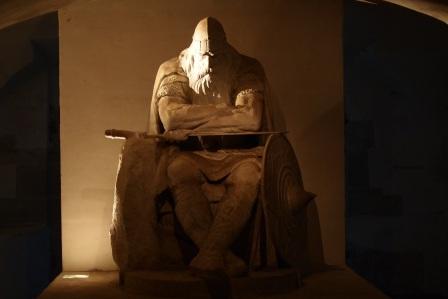
Generator Hostel in Copenhagen was great. It was hip, had all the necessary facilities for intercultural exposure as is expected for top-European hostels apart from being clean and well-organized: a first floor with front desk, bar, dance floor, giant tv-screens, outdoor porch seating and people from all over the world, mostly young. Hostels are great because of this intercultural vibe, often inexpensive, although our lodgings were on the luxury 5th floor, that is, rooms with private bathrooms. It was fun watching the world cup soccer games with people from over the world rooting for different teams in all friendliness. Go USA!
Our first itinerary in Copenhagen was heavy on castles. We started seeing the picturesque, renaissance Rosenborg Castle in the central King’s Garden. Apart from its beautiful architecture it is overflowing with artistic riches inside gathered by the crown since Christian IV began building the castle in 1606: gold, silver, porcelain, portraits royals had made of themselves, busts, jewelry, oddities including one stunning 16th century guitar.
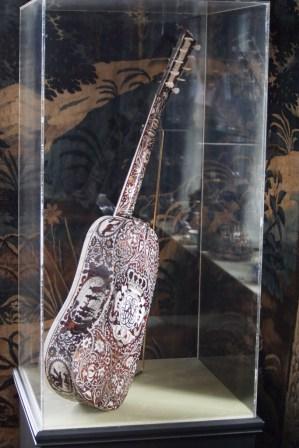
We then proceeded to Amalienborg Palace, the official residence of the Queen, where one of its four octagonal palaces now is accessible to the public. Here we get a feel for how the more recent royals lived as we see their private offices, old telephones, living rooms etc. as we gently trot around with our shoes covered in blue protective sleeves.
We were then guided through Christiansborg Palace which apart from housing the Danish parliament contains impressive ball rooms and reception rooms for foreign dignitaries. Finally, by late afternoon we were totally palaced-out, filled as we were with intense impressions of the rhetoric of officialdom.
Our excursion the next day to the ancient city of Roskilde with the immense Gothic cathedral and the Viking Ship Museum took us to a town of a different pace than the busy capital. The name Roskilde comes from ‘Roar’s kilde’ meaning Roar’s spring. The town has been continuously inhabited since the 6th century when King Roar reigned and obviously appropriated the spring. It still bubbles out of the ground right next to the high school on the way down from the cathedral to the Viking ship museum on the waterfront. Since early medieval time folks had known that some ships were sunk out there in the shallow fjord. In 1962 five Viking ships from the 11th century were excavated by being walled up in the middle of the fjord and all water pumped out. Then the fjord-bottom sludge was rolled back and the ships recovered bit by bit. They were then carefully treated with chemical solutions for open-air preservation and placed in the museum built to house them at the edge of the fjord. The painstaking job has been called a thousand-piece jigsaw puzzle.
The Danes adopted a more scientifically puritan approach than the Norwegians only exhibiting the actual pieces found at the bottom of the fjord placing them within a frame of steel bars in the shape of the original ship. Among the five there is a long, lean and fast war ship and a more stout, heavy merchant vessel for a variety of goods. The Norwegians had master carpenters augment missing or damaged pieces reconstructing their ships to near original form. Both methods work. The Danish ships were sunk to block access by unknown or enemy vessels to Roskilde while the locals themselves knew the secret route.
In Byparken, the park between the cathedral and the ships, we came across Pipers Hus Café and Restaurant. We settled at the tables outside in the sunshine and each of us ordered an open-faced sandwich from the menu. This is the traditional Danish lunch-stable although typically not in the carefully if not exquisitely prepared version we find at good restaurants. Pipers Hus did not let us down. A single piece on rye with a variety of toppings is the perfect size for lunch, eaten with knife and fork. My warm, home-made liver pate on dark, firm rye bread with lettuce, topped with freshly fried bacon, beets and chives still lifts my spirits by the mere thought of it.
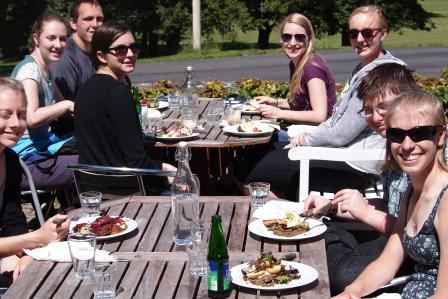
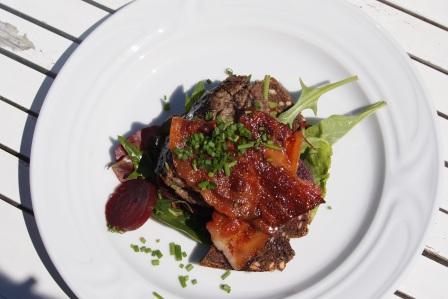
They began building Roskilde cathedral in the 12 century and it has been updated and restored since. Now a regal monument in red brick, and still an active church, it sports the graves of 39 Danish kings and queens, and not a few aristocrats buried in the floors along the isles. They were rich and powerful enough to get inside; their marble grave-slabs being polished as we trot along following our guide. She took us through a selection of royal coffins and the macabre tales of European politics that often underwrote royal marriages. She had been present when several coffins had been opened to examine their content and thus enhanced our visit with a spooky, gothic presence.
We learned that Queen Margrethe II of Denmark (1940- ) has decided she would rather be buried inside the cathedral than outside in the adjacent chapel which her more modest father, the beloved Frederik IX (1899-1972), had built for himself, his queen, and his family. She has had the holy Sct. Birgitta’s chapel (inaugurated 1464 and of the most authentic, medieval atmosphere) cleared from old, unnecessary bones for her mausoleum to be built there by contemporary Danish pop-artist, Bjørn Nørgaard, who gained fame in the 60s for sacrificing a live horse on a snow-covered, frozen field, with an axe, a long-time favorite of the Queen.

Thus we secure our historical importance. Although, to my thinking, being Queen Margrethe I (1353-1412) of a united Scandinavia in the 14th century, whose massive, marble sarcophagus graces the main floor of the cathedral, is one thing, and being a constitutional monarch in the 21st century must be something entirely different.
Contrasting people of ancient history and their social environments with our present and our social expectations, is a complex and fascinating undertaking and fundamental to our various occupations in the social sciences and the humanities. It is through careful, rational scholarship and teaching we have a chance of understanding our pasts rather than from, admittedly, the more accessible, fluffy story-telling and bad movies. Whether we gather economic data to assess how those societies actually functioned or examine their literature to construct our understanding of them, through such investigations we enrich our critical understanding of ourselves as their actions and behaviors become a mirror to our own. For example, undoubtedly, back then, those with family ties or access to power would invariably tilt it towards themselves and perhaps, back then, ordinary people looking on would have no means or even inclination to protest.
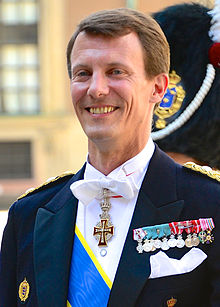
Queen Margrethe II’s younger son, Prince Joachim (1969- ), Knight of the Order of the Elephant (R.E.), Grand Commander of the Order of the Dannebrog (S.Kmd.), The Silver Jubilee Medal of Her Majesty The Queen, Commemorative 75th Birthday Medal of His Royal Highness The Prince Consort, Commemorative 70th Birthday Medal of Her Majesty The Queen, Commemorative Ruby Jubilee Medal of Her Majesty The Queen; Belgium: Grand Cross of the Order of the Crown; Brazil: Grand Cross of the Order of the Southern Cross; Bulgaria: Member 1st Class with swords of the Order of Stara Planina (2006); Finland: Grand Cross of the Order of the White Rose of Finland; Germany: Grand-Cross of the Order of Merit of the Federal Republic of Germany; Greece: Grand Cross of the Order of the Phoenix; Japan: Grand Cordon of the Order of the Chrysanthemum; Jordan: Grand Cordon of the Supreme Order of the Renaissance; Luxembourg: Grand-Cross of the Order of Adolphe of Nassau; Nepal: Member First Class of the Order of Tri Shakti Patta (Three Divine Powers); Norway: Grand Cross of the Order of Saint Olav; Romania: Grand Cross of the Order of the Star of Romania; and Sweden: Commander Grand Cross of the Order of the Polar Star – was in 1993 by a childless aristocratic couple given a 13th century castle with vast landholdings for him to manage following his degree in agricultural management. His skills at such management apparently lacking as he over the years quietly mortgaged the place, which he had been given, in excess of DKK 40.000.000 ($7.300.000) to make things work and to maintain the necessary life-style. He was this year salvaged from bankruptcy by a circle of affluent Danes who in gracious concern purchased the castle from him, which he had been given, for approx. $18.000.000, of which he immediately spent a good $7.000.000 buying himself a mansion in the posh suburbs of northern Copenhagen, to maintain the necessary life-style for him and his family. To the extent the Danish populous practice collective sublimation, the monarchy rests on a pillar of popular support.
Good stuff for Honors students to learn from.
The train trip out of Denmark to Stockholm took about 5 hours. A great time to relax, write the journal, or enjoy the beautiful Swedish countryside of fields, lakes, forests, little towns, hills, and rock formations as we came further north. Right out of Copenhagen, spectacularly, we first crossed the sound between Denmark and Sweden on the 10 mile combined tunnel and high-bridge crossing. A new linguistic term: Øresundsbron has been invented to symbolize the cooperation between the two countries: Øresund – the Danish name for the sound – and bron – Swedish for bridge.
We emerged at Stockholm Central and headed to Af Chapman, the famous 3-masted ship-hostel moored in central Stockholm with a direct, unencumbered view of the Old Town and the Royal castle straight across. After each of us had received a hostel plastic-bag with fresh linens, definitely a first for all students, we bunked below like sailors; showers and bathrooms down the hall. I checked later that everybody eventually had figured out how use the linens to make the bunks. After that we walked to the Old Town and got a feel for its layout in cobblestoned, narrow streets suddenly opening up to a picturesque square.
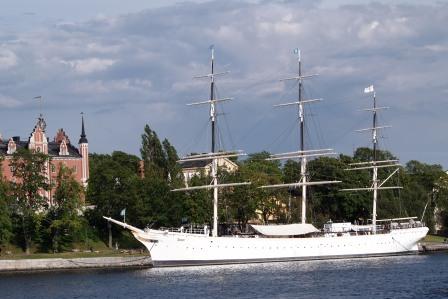
We eventually found my favorite fast-food stand: fresh, fried stromming (a herring type of fish) in a hamburger bun with lettuce, onion and tartar sauce. Raves from everybody!
The next day we started with a history lesson at a guided tour of the huge Royal Palace with 1430 rooms, 660 with windows. Intriguing how those palaces burned and were rebuilt again and again, the kitchen ovens typically the culprit. At the palace they have an instructive series of models displaying the different stages of development over the centuries from its original state to its current. With great sense of pedagogical suspense the guide said: “Which one of these castles would you rather visit?” and everybody pointed to the model of the original medieval structure which indeed looked like something out of the Disney corporation. She proceeded confidently, not hiding her disappointment in us, to extoll the virtues of the current baroque structure completed in 1760. If the king looked out the window he would see us writing our journals at the top deck of Af Chapman.
Later our guide at Stockholm City Hall explained how the Nobel Award banquets transform the hall from its daily administrative purpose to hosting the world-wide event. How the marble staircase leading to galleries and feast-halls of the upper floor was carefully constructed to accommodate high heels and flowing gowns. The architect had his wife run up and down in her finest. She also told us how students at Sweden’s universities are chosen by lotto to be ushers at the banquets guiding international dignitaries, heads of state, and award winners. Decisive scenes from Swedish history are illustrated in gold-covered mosaics and fill the walls such as the Stockholm Bloodbath seen here (more below).
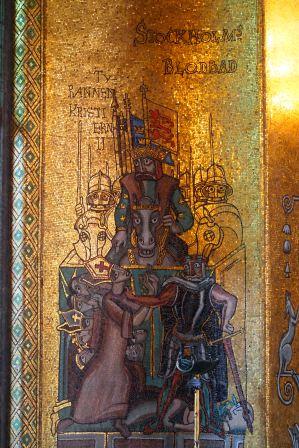
Norway and Denmark have their Vikings ship museums but in terms of volume Sweden trumps with the Vasa Ship. Militarily ambitious King Gustavus II Adolphus of Sweden (1594-1632) had the highly decorated ship built to further his European conquests. Sporting several canon decks much speculation has surrounded the ambitious king’s possible late demands that the war ship be taller, more massive, more impressive, than perhaps the master shipwrights had intended. On 10 August 1628 it left for its maiden voyage to the war theatre in Poland but, alas, after 20 minutes downstream from central Stockholm the thing tipped over and went down with mice and men to the tune of plenty of embarrassment. The following inquiry decided that no one should be held responsible for the resounding fiasco.
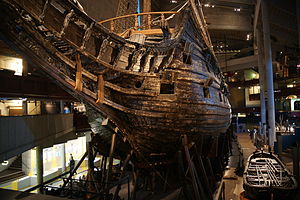
It stayed there until it was relocated in 1956 and finally raised on 24 April 1961 in a gigantic rescue operation after 333 years at the bottom of the fjord. It was then towed back to town and eventually parked in the Vasa Ship Museum built to house it. It is now Sweden’s chief tourist destination and judging by the massive hordes of those must make enough profits to balance the well-fare state’s budget. It is awesome and has now come to good use.
Full-masted in its original form it takes up almost all space of the 34m tall building. Excellent hands-on exhibits in side-galleries of life on a 17th century wooden warship bring history alive. Splendid tour guides take us around for free. We learned that getting a job managing a canon was a way out of perpetual proletarian-hood even if food consisted of tasteless gruel and you had to sleep next to the canon. I think, such extreme class-determined life-conditions can be played over and over again in front of our eyes and ears and are still difficult to imagine or understand.
The students loved lounging in the lounge chairs on deck in the sunshine looking at Stockholm and its busy waterways as we got ready for evening events. One night we found an Irish Bar with a great TV-room in the basement in Old Town Stockholm. Its medieval brick walls caving in on us as we cheered the world cup game between France and Germany (0-1). A friendly British couple from Knutsford, England (Man U supporters) shared their polite view of the Swedes although they weren’t particularly amused when I referred to England as ‘good old Scandinavian land.’ Well, at least when Knut was there, it was.
We also entertained more civilized pursuits. We attended an evening organ concert in Storkyrkan, Old Town’s grand cathedral, for music by Johan Sebastian Bach (1685-1750). His very last composition Vor Deinem Thron Tret Ich Hiermit (1750) was particularly moving. The cathedrals of Europe are the best concert houses in summer. The grandiose rooms themselves are spectacular and always decorated with gripping scenes from legend and myth. Storkyrkan displays Notke’s stunning statue of Saint George and the Dragon (1484) with a presence and drama accentuated by the organ’s mesmerizing tonal landscape.
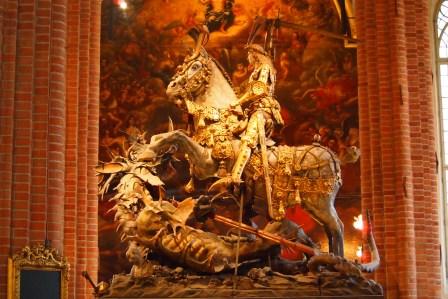
Bach’s deeply stirring music and Saint George’s struggle with the dragon analogized the Stockholm Bloodbath which took place right outside the cathedral in 1520. Christian II of Denmark had lured a good hundred Swedish nobility to Stockholm, which he had over-powered, under the pretext of amnesty and reconciliation. Instead he had them beheaded. This sleazy act only fuelled righteous sentiments of revolt soon to follow amplifying hostile sentiments between the two close neighbors and not abating until modern time.
So much history in so few centuries.
Physically and mentally exhausted after fifteen days of intense travel we got up early Sunday morning, said our farewells to Af Chapman, and left for Arlanda Airport. There we boarded our steely air-steeds, caught the wind, and headed home.
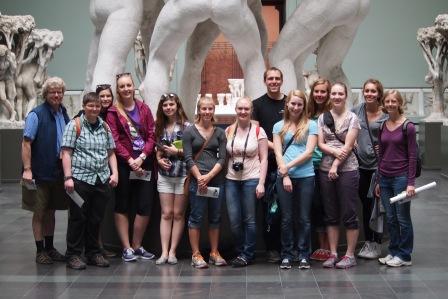
(All photos by K. Andersen except the photos of Prince Joachim and the Vasa ship, both Wikipedia).

